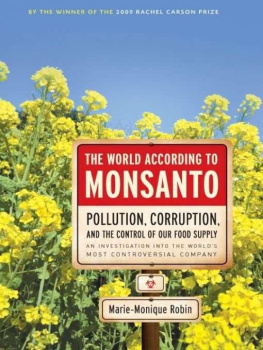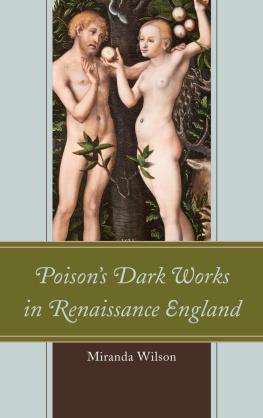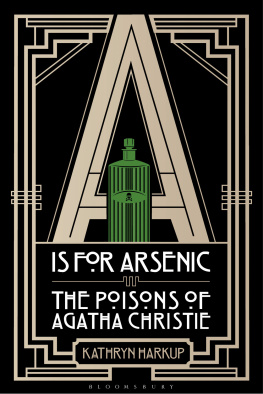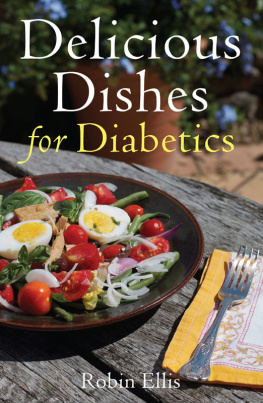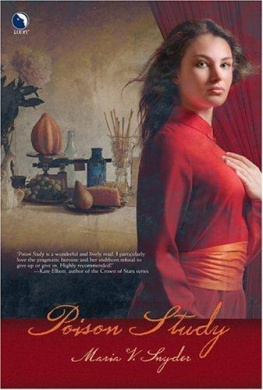Our Daily Poison
Also by Marie-Monique Robin
The World According to Monsanto: Pollution, Corruption, and the Control of Our Food Supply

Cet ouvrage publi dans le cadre du programme daide la publication bnficie du soutien du Ministre des Affaires Etrangres et du Service Culturel de lAmbassade de France represnt aux Etats-Unis. This work received support from the French Ministry of Foreign Affairs and the Cultural Services of the French Embassy in the United States through their publishing assistance program.
The New Press gratefully acknowledges the Florence Gould Foundation for supporting publication of this book.
2014 by Editions La Dcouverte, ARTE Editions, Paris, France, 2011
English translation copyright 2014 by The New Press
Originally published in France as Notre Poison Quotidien by Editions La Dcouverte, Paris, 2011
All rights reserved.
No part of this book may be reproduced, in any form, without written permission from the publisher.
Requests for permission to reproduce selections from this book should be mailed to: Permissions Department, The New Press, 120 Wall Street, 31st floor, New York, NY 10005.
Published in the United States by The New Press, New York, 2014
Distributed by Perseus Distribution
LIBRARY OF CONGRESS CATALOGING-IN-PUBLICATION DATA
Robin, Marie-Monique.
[Notre poison quotidien. English]
Our daily poison : from pesticides to packaging, how chemicals have contaminated the food chain and are making us sick / Marie-Monique Robin ; translated by Allison Schein and Lara Vergnaud.
pages cm
Originally published in French as: Notre poison quotidien (Paris : Dicouverte, 2011).
Includes bibliographical references and index.
ISBN 978-1-59558-930-9 (e-book)
1. Environmental toxicology. 2. Chemical industryEnvironmental aspects. 3. Chronic DiseaseEnvironmental aspects. 4. ChemicalsPhysiological effect. 5. PesticidesPhysiological effect. 6. Food contamination. I. Title.
RA1226.R6213 2014
363.738'498dc23
2014027768
The New Press publishes books that promote and enrich public discussion and understanding of the issues vital to our democracy and to a more equitable world. These books are made possible by the enthusiasm of our readers; the support of a committed group of donors, large and small; the collaboration of our many partners in the independent media and the not-for-profit sector; booksellers, who often hand-sell New Press books; librarians; and above all by our authors.
www.thenewpress.com
Composition by Westchester Publishing Services
This book was set in Fairfield Light Italic
2 4 6 8 10 9 7 5 3 1
Contents
Our Daily Poison
Will this book be the sequel to The World According to Monsanto? I have constantly been asked this question since 2008 when I announced at a lecture or a debate that I was working on a new project. Yes and no: this book is and is not a sequel to Monsanto, even though the material is obviously related to the earlier investigation. Indeed, books and filmsfor me the two are closely connectedare like pearls on a necklace or pieces of a jigsaw puzzle: they follow one another and fit together without my realizing it. They arise indirectly from and are nourished by the questions growing out of the work that went before. And they end up taking their place as links in a single chain. In every case the process at work is the same: the wish to understand in order to then communicate to the widest audience the knowledge gained.
Three Questions About the Role of the Chemical Industry
So, Our Daily Poison is the outcome of a long process that began in 2004. At the time, I was worried about the threats weighing on biodiversity: in two documentaries broadcast on Arte on the patenting of live organisms and the history of wheat,sovereignty of the peoples of the world. I also found that the celebrated green revolution went along with an impoverishment of natural resources (soil and water quality) and widespread pollution of the environment because of the massive use of chemical products (pesticides and artificial fertilizers).
This trilogy quite naturally led me to develop an interest in the American company Monsanto, one of the major promoters and beneficiaries of the green revolution: first because it was (and continues to be) one of the principal manufacturers of pesticides in the twentieth- and twenty-first centuries; and because it has become the largest seed producer and is trying to take control of the food chain by means of patented transgenic seeds (genetically modified organisms [GMOs]). I can never adequately express my surprise at discovering the many lies, manipulations, and dirty tricks the Saint Louis firm is capable of to keep highly toxic chemical products on the market, whatever the environmental, health, and human costs.
And as I advanced in this thriller of modern times, to quote the sociologist Louise Vandelac, who wrote the preface for the Canadian edition of Le Monde selon Monsanto, three questions constantly plagued me. Was Monsanto an exception in industrial history, or, on the contrary, does its criminal conduct (I choose my words carefully) characterize the majority of chemical product manufacturers? One question led to another, and I also wondered how the approximately one hundred thousand synthetic chemical molecules that have invaded our environment and our dinner plates for a half century are evaluated and regulated. Finally, is there a link between exposure to these chemical substances and the spectacular increase in cancers, neurodegenerative diseases, reproductive disorders, diabetes, and obesity that have been recorded in developed countries, to such a degree that the World Health Organization (WHO) speaks of an epidemic?
To answer these questions, I decided in this new investigation to focus solely on the chemical substances that come into contact with the food chain, from the farmers field (pesticides) to the consumers plate (food additives and food grade plastics). Thus this book will not address electromagnetic waves, mobile phones, or nuclear pollution, but solely the synthetic molecules we are exposed to in our environment and our foodour daily bread that has largely become our daily poison. Knowing that the subject is highly controversialwhich is not surprising considering the importance of the economic stakes involvedI have chosen to proceed methodically, starting from the simplest example that is least open to question, namely, acute and chronic poisoning of farm workers directly exposed to pesticides, and moving gradually to the most complex issue, the effects at low doses of the residues of chemical products that we all have in our bodies.
Gathering the Pieces of the Puzzle
Our Daily Poison is the product of a long investigation that mobilized three kinds of resources. I first consulted about a hundred books, written by historians, sociologists, and scientiststhe majority from North America. My study thus owes a good deal to the invaluable research carried out by highly talented academics like Paul Blanc, professor of occupational and environmental medicine at the University of California, his historian colleagues Gerald Markowitz and David Rosner, and David Michaels, an epidemiologist appointed head of the U.S. Occupational Safety and Health Administration (OSHA), the agency in charge of workplace safety. Their thoroughly documented books provided access to a mass of unpublished archives and helped me locate the subject of my investigation in a broader context of industrial history.
So, I went back to the origins of the industrial revolution, which preceded the green revolution, two faces of the same insatiable monster: progress, supposed to bring us universal happiness and well-being; but all indications are that, like a modern-day Saturn, progress threatens to devour its own children. Without this historical view, it is indeed impossible to understand how the regulatory system for chemical products was invented and still operates todaya system rooted in the persistent contempt of manufacturers and public authorities for the factory workers who paid a heavy tribute to the chemical madness of so-called developed societies.
Next page

